Слайд 1CRIMEAN FEDRAL UNIVERSITY NAMED AFTER V.I.VERNADSKY MEDICAL
ACADEMY NAMED AFTER S.I.GEORGIEVSKY
ADOPTIVE POPULATION
BY:MOHAN KUMAR AMARNATH
GROUP : 191 B
TEACHER:Phd.Svetlana smirnova
Слайд 2.ADAPTIVE TYPE OF POPULATION
Adaptive type – in evolutionary biology – is any population or taxon which have
the potential for a particular or total occupation of given
free of underutilized home habitats or position in the general economy of nature. In evolutionary sense, the emergence of new adaptive type is usually a result of adaptive radiation certain groups of organisms in which they arise categories that can effectively exploit temporary, or new conditions of the environment.
Such evolutive units with its distinctive – morphological and anatomical, physiological and other characteristics, i.e. genetic and adjustments (feature) have a predispositiona for an occupation certain home habitats or position in the general nature economy.
Simply, the adaptive type is one group organisms whose general biological properties represent a key to open the entrance to the observed adaptive zone in the observed natural ecological complex.
Слайд 3Adaptive types are spatially and temporally specific. Since the frames
of general biological properties these types of substantially genetic are defined between, in effect
the emergence of new adaptive types of the corresponding change in population genetic structure and eternal contradiction between the need for optimal adapted well the conditions of living environment, while maintaining genetic variation for survival in a possible new circumstances.
For example, the specific place in the economy of nature existed millions of years before the appearance of human type. However, just when the process of evolution of primates (order Primates) reached a level that is able to occupy that position, it is open, and then (in leaving world) an unprecedented acceleration increasingly spreading. Culture, in the broadest sense, is a key adaptation of adaptive type type of Homo sapiens the occupation of existing adaptive zone through work, also in the broadest sense of the term.
Слайд 4NATURAL SELECTION
Natural selection only acts on the population’s heritable traits:
selecting for beneficial alleles and thus increasing their frequency in
the population, while selecting against deleterious alleles and thereby decreasing their frequency—a process known as adaptive evolution. Natural selection does not act on individual alleles, however, but on entire organisms. An individual may carry a very beneficial genotype with a resulting phenotype that, for example, increases the ability to reproduce (fecundity), but if that same individual also carries an allele that results in a fatal childhood disease, that fecundity phenotype will not be passed on to the next generation because the individual will not live to reach reproductive age. Natural selection acts at the level of the individual; it selects for individuals with greater contributions to the gene pool of the next generation, known as an organism’s evolutionary (Darwinian) fitness.
Fitness is often quantifiable and is measured by scientists in the field. However, it is not the absolute fitness of an individual that counts, but rather how it compares to the other organisms in the population. This concept, called relative fitness, allows researchers to determine which individuals are contributing additional offspring to the next generation, and thus, how the population might evolve.
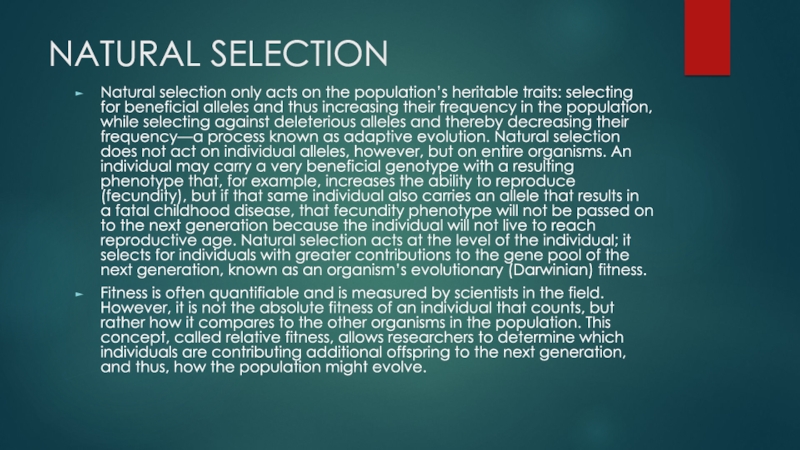
Слайд 5BIOLOGICAL ADOPTATION OF ARCTIC INDIGENOUS PEOPLE
Climate change is having the
most dramatic impact on the Arctic with a temperature increase
twice the magnitude of the increase in the rest of the world. This is resulting in significant sinking of the ice in the Arctic Sea. Satellite images of the ice show that it currently has the smallest area in recorded history. If left unchecked, climate change in the Arctic will lead to a faster rise in sea level, more frequent and increasingly intense storms and winds, further decreases in the extent of sea ice, and increased erosion due to higher waves.
This consequence of climate change will have a number of effects on the Inuit people in a variety of ways. Eroding coasts and thinning ice have changed the migration patterns of the numerous animal species such as killer whales, marine polar bears, caribou, and seals . Seals are one of the numerous animals hunted by the Inuit people upon which they depend. The seals are just one of the various species whose population is diminishing due to melting of ice sheets on which they are dependent for raising their young on. Additionally, the rapid melting of the sea ice creates a more hazardous and unpredictable terrain to hunt in, posing a new risk within their subsistence economy.
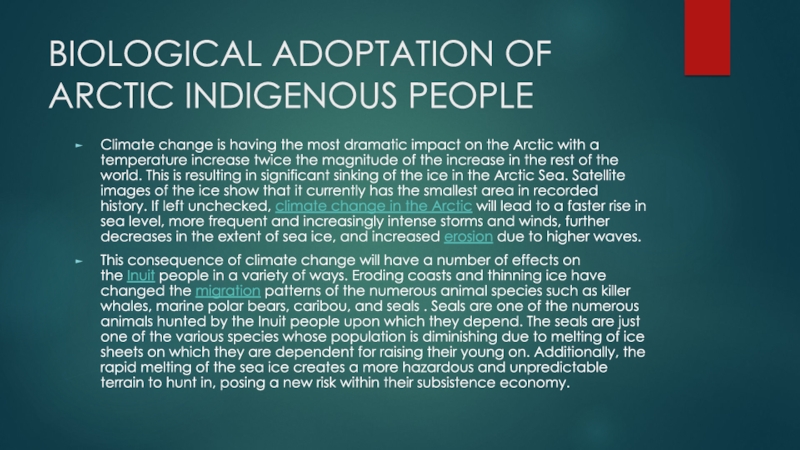
Слайд 6BIOLOGICAL ADOPTATION OF ARCTIC INDIGENOUS PEOPLE
Simultaneously, increased temperatures and melting
permafrost will make it harder for Inuit people to freeze
and store food in their traditional way. Furthermore, climate change will bring new bacteria and other micro-organisms to the region, which will bring yet unknown effects to the Peoples of the region.
One example of the Indigenous groups acting in response to climate change in the Arctic was the Alaska Inter-Tribal Council taking action regarding the decline in the polar bear population that was directly linked to the decline in ice sheets for them to live on. The Alaska Natives rely on polar bears and cohabit with them and through their Indigenous knowledge have contributed to the co-management with the U.S. federal government to increasing and improving conservation efforts regarding the popular megafaund.
Слайд 8SOCIAL ADOPTATION OF ARCTIC INDIGENEOUS PEOPLE
Identified impacts are numerous. Many
Arctic indigenous communities are characterized by mixed economic systems, where
formal or cash economy based on employment and public transfers is combined with informal, subsistence economy, as part of food and clothing originates from hunting or fishing (AHDR, 2004; Nuttall, 2002). Both components are crucial for life in remote communities, not only in economic terms. Harvesting or reindeer herding constitute the core of culture and social relations. The retreat of sea ice – an icon of Arctic warming – bears implications for subsistence livelihoods. Many Arctic coastal communities rely on Arctic species, distribution of which depends on the sea ice.
The ice is indispensable for transport and hunters cannot no longer trust their traditional knowledge and experience in the light of changing ice conditions. When coupled with coastal erosion and storm surges, the effects on Arctic communities can be dramatic, with the likely need for costly relocation of some settlements (ACIA, 2005; Ford et al., 2010; Hovelsrud and Smit, 2010). Kivalina village in Alaska is perhaps the best known example of a community affected to such an extent by coastal erosion, with relocation expected to cost around or above USD 100 million. Changes in ocean ecosystems, like warming waters or currently emphasized ocean acidification, may influence the distribution of marine species and affect people engaged in fisheries.
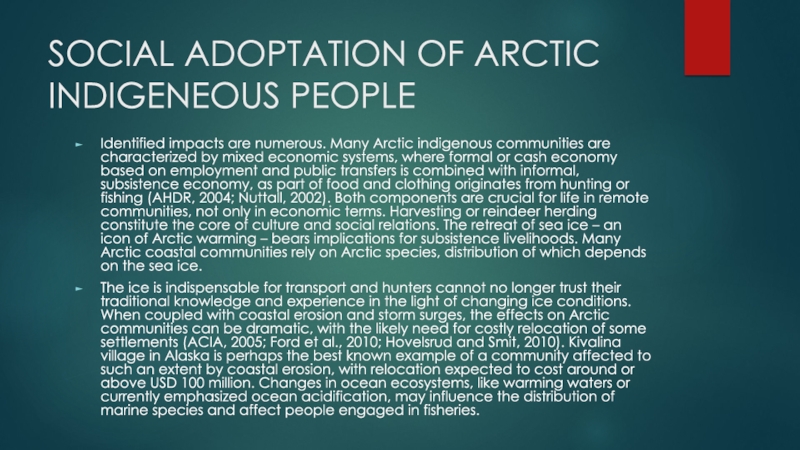
Слайд 9SOCIAL ADOPTATION OF ARCTIC INDIGENEOUS PEOPLE
The problems faced by coastal
communities are perhaps the most vivid for the global public.
However, such focus on the problems typical for the Inuit, although understandable, has often obscured the observed and predicted impacts on terrestrial social-environmental systems and other Arctic peoples. The changes in snow cover and thawing permafrost are, in many places, of greater consequence than retreating sea ice. Traditional livelihoods, such as reindeer herding – an iconic Arctic livelihood across Eurasia – face challenges as the availability of food for the reindeer is affected. In some locations, winter transport depends on snow conditions and ice on lakes and rivers.
The thawing permafrost is a problem for many communities, as housing and water supplies, but also oil and gas pipelines or roads, may be at risk (ACIA, 2005). The phenomenon of Arctic greening and northward movement of ecosystem zones (CAFF, 2013) reshape the landscape which forms the basis of Arctic livelihood. The impacts on livelihoods are not confined to the subsistence activities themselves, as they have implications for the viability of indigenous traditional ecological knowledge, group identity, or inter-generational transmission of culture. Researchers also highlight the human health risks connected with the appearance in the North of invasive species and vector-borne diseases
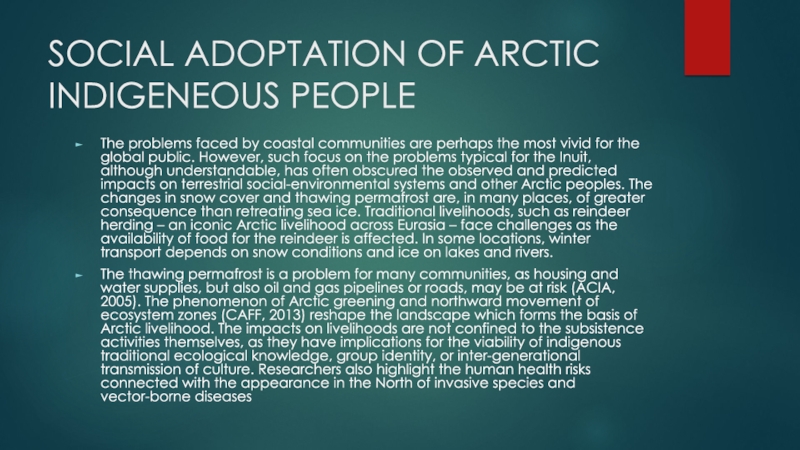
Слайд 11INHABITANTS OF THE TROPICS
Tropical rainforests have long been home to
indigenous peoples who have shaped civilizations and cultures based on
the environment in which they live. Great civilizations like the Mayas, Incas, and Aztecs developed complex societies and made great contributions to science. Living from nature and lacking the technology to dominate their environment, native peoples have learned to watch their surroundings and understand the intricacies of the rainforest. Over generations these people have learned the importance of living within their environment and have come to rely on the countless renewable benefits that forests can provide.
Слайд 13INHABITAN OF THE ARID REGION
One example of people who live
in the desert is the Bedouin tribe. They live in
desert areas in the Middle East. Their traditional lifestyle has adapted to these extremely arid conditions.
Their nomadic lifestyle means they do not settle in one area for long. Instead, they move on frequently to prevent exhausting an area of its resources.
They have herds of animals which are adapted to living in desert conditions, such as camels.
Their tents are built to allow air to circulate within them, keeping them cool. Animal hair is used to insulate them, to keep the tent cool during the day and warmer at night.
Modern adaptations to arid conditions
A satellite image of Las Vegas
With both money and technology, desert areas can be developed to cater for modern lifestyles. Las Vegas, in the Mojave Desert, is one of the fastest-growing cities in the USA. The city of Las Vegas is lush and green in comparison with the surrounding desert.
This is possible because 90 per cent of the water Las Vegas needs is imported from the Colorado River. The remaining 10 per cent comes from ground water. The demand for water is not sustainable and the city has started to plan to reduce the demand for water. One way is that new homes have restrictions on the amount and type of lawns that they can have. The authority also recycles water where it can.
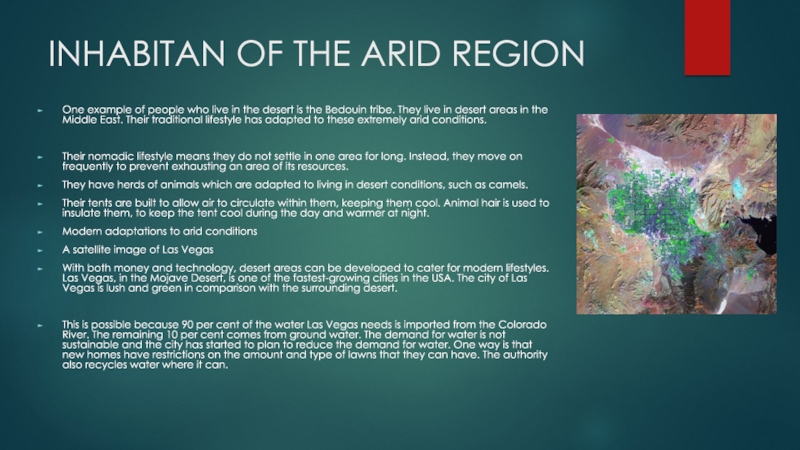
Слайд 14ADOPTATION OF PLANT AND ANIMAL IN ARIS REGION
PLANTS
thick, waxy skin
to reduce loss of water and to reflect heat
large, fleshy
stems to store water
thorns and thin, spiky or glossy leaves to reduce water loss
spikes protect cacti from animals wishing to use stored water
deep roots to tap groundwater
long shallow roots which spread over a wide area
plants lie dormant for years until rain falls
ANIMALS
long eye lashes, hairy ears and closing nostrils help to keep out sand
thick eyebrows which stand out and shade eyes from the sun
wide feet so they don't sink in the sand
they can go without water for over a week because they can drink gallons in one go
they can go months without food - they store fat in their humps
body temperature can change to avoid losing water through sweating
they are well camouflaged
thick fur helps to keep them warm at night
Слайд 16INHABITANT OF THE ISLAND
Islands are home to some 600 million
people—one-tenth of the world's population. Many islanders are endowed with
unique cultures and derive much of their economic, environmental and cultural well-being directly or indirectly from the rich natural resources in their immediate environment. Islands harbour numerous discrete ecosystems, from mountain forests to wetlands and beyond, that provide food, fresh water, wood, fibre, medicines, fuel, tools and other important raw materials, in addition to aesthetic, spiritual, educational and recreational values, that support island livelihoods, economies and cultures. Island ecosystems also contribute to the maintenance of ecosystem functions: they provide defence against natural disasters, support nutrient cycling, and soil and sand formation; and they contribute to the regulation of climate and diseases.
While much the same can be said of biodiversity in other settings, the components of biodiversity and the ecosystem services they provide is all the more critical on islands. Island economies, particularly those of Small Island Developing States (SIDS), are among the most vulnerable of the developing countries, considering the relative lack of economic alternatives available and such factors as:
· Small populations and economies
· Weak institutional capacity in both the public and the private sector
· Remoteness from international markets
· Susceptibility to natural disasters and climate change (including in particular sea-level rise from climate change)
· Fragility of land and marine ecosystems
· High cost of transportation
· Limited diversification in production and exports
· Dependence on international markets, export concentration, and income volatility
· Vulnerability to exogenous economic shocks.
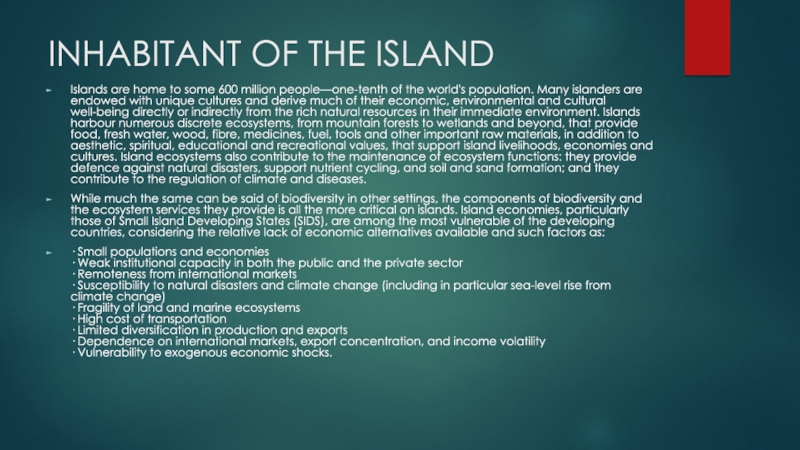
Слайд 18INHABITANT OF THE ISLAND
These challenges and vulnerabilities prompted Agenda 21 (chapter 17,
section G; 1992), followed by the Barbados Programme of Action (1994) and
the Plan of Implementation of the World Summit on Sustainable Development (2002), to call small island developing States and islands supporting small communities “a special case both for environment and development.”
For example, biodiversity is a crucial component of food security in many small, isolated islands, especially SIDS. Small islands comprise a high proportion of marine and coastal areas, which are important sources of income. The continental shelves and coastal ecosystems of many SIDS are of major economic significance for settlement, subsistence and commercial agriculture, fisheries, and tourism. Coastal ecosystems also fulfill many ecological roles, ranging from shoreline protection to buffer zones from land-based activities and pollution, to feeding, breeding, and nursery grounds to many marine species. Coral reefs provide an estimated US$ 375 billion per year in goods and services to the world. This includes support for marine fisheries, which provide the principal protein source for many island populations, especially amongst SIDS.
Yet island biodiversity is not only of vital importance to island dwellers. Islands are repositories of genetic information whose present-day biodiversity stands as a record of millions of years of evolution. This biodiversity has an inherent value to humankind the world over.
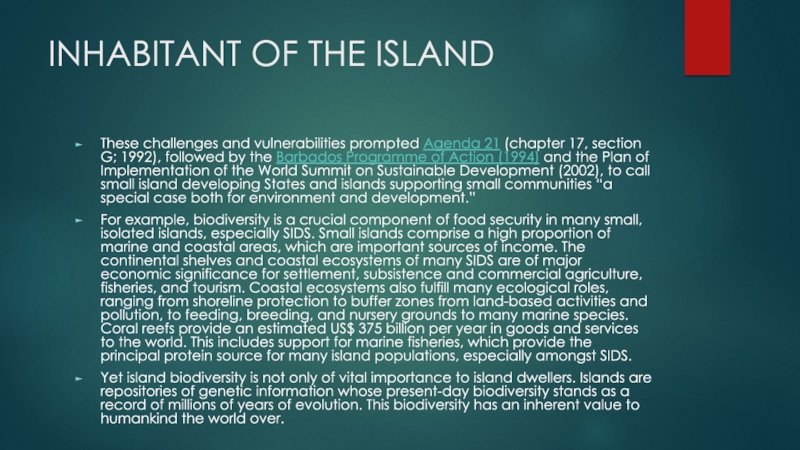
Слайд 19RELATED VEDIO LINK
https://www.youtube.com/watch?v=WJayMGhZxO0
https://www.youtube.com/watch?v=TDtTSQsMC
https://www.youtube.com/watch?v=q2zdiLn3gSENA